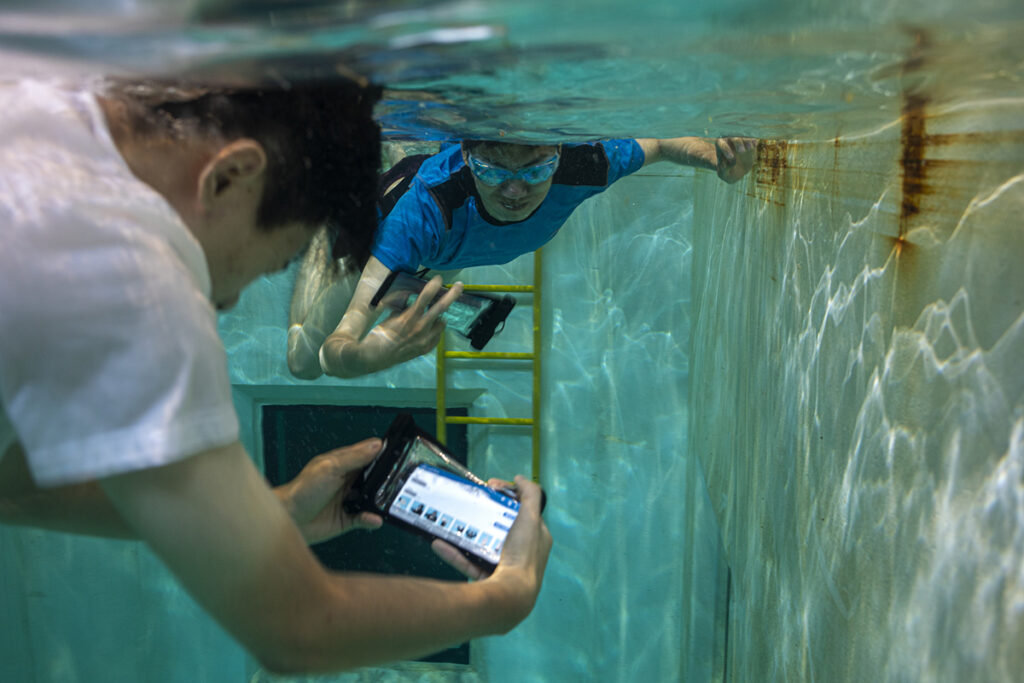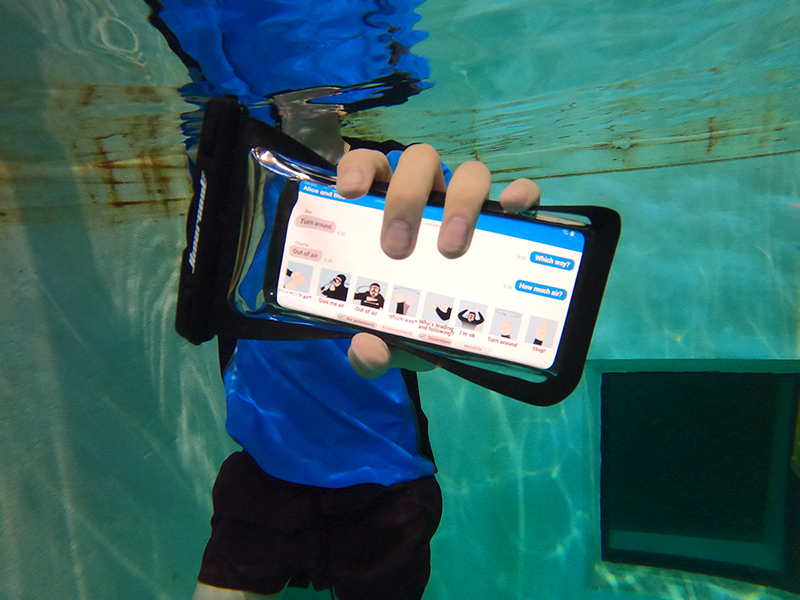For millions of people who participate in activities such as snorkeling and scuba diving each year, hand signals are the only option for communicating safety and directional information underwater. While recreational divers may employ around 20 signals, professional divers’ vocabulary can exceed 200 signals on topics ranging from oxygen level, to the proximity of aquatic species, to the performance of cooperative tasks.
The visual nature of these hand signals limits their effectiveness at distance and in low visibility. Two-way text messaging is a potential alternative, but one that requires expensive custom hardware that is not widely available.
Researchers at the University of Washington show how to achieve underwater messaging on billions of existing smartphones and smartwatches using only software. The team developed AquaApp, the first mobile app for acoustic-based communication and networking underwater that can be used with existing devices such as smartphones and smartwatches.
“Smartphones rely on radio signals like WiFi and Bluetooth for wireless communication. Those don’t propagate well underwater, but acoustic signals do,” said co-lead author Tuochao Chen, a Ph.D. student in the Allen School. “With AquaApp, we demonstrate underwater messaging using the speaker and microphone widely available on smartphones and watches. Other than downloading an app to their phone, the only thing people will need is a waterproof phone case rated for the depth of their dive.”
The AquaApp interface enables users to select from a list of 240 pre-set messages that correspond to hand signals employed by professional divers, with the 20 most common signals prominently displayed for easy access. Users can also filter messages according to eight categories, including directional indicators, environmental factors, and equipment status.
In building the app, Chen and his collaborators — co-lead author and fellow Ph.D. student Justin Chan and professor Shyam Gollakota — had to overcome a variety of technical challenges that they haven’t previously encountered on dry land.
“The underwater scenario surfaces new problems compared to applications over the air,” explained Chan. “For example, fluctuations in signal strength are aggravated due to reflections from the surface, floor and coastline. Motion caused by nearby humans, waves and objects can interfere with data transmission. Further, microphones and speakers have different characteristics across smartphone models. We had to adapt in real time to these and other factors to ensure AquaApp would work under real-world conditions.”
Those other factors include the tendency for devices to rapidly shift position and proximity in the current and the various noise profiles the app might encounter due to the presence of vessels, animals, and even low-flying aircraft.
The team created an algorithm that allows AquaApp to optimize, in real time, the bitrate and acoustic frequencies of each transmission based on certain parameters, including distance, noise and variations in frequency response across devices. When one user wants to send a message to another device, their app first sends a quick note, called a preamble, to the other device. AquaApp on the second device runs the algorithm to determine the best conditions to receive the preamble; it then tells the first device to use those same conditions to send the actual message.
The researchers developed a networking protocol to share access to the underwater network, akin to how WiFi networks referee internet traffic, to support messaging between multiple devices. AquaApp can accommodate up to 60 unique users on its local network at one time.
The team tested the real-world utility of the AquaApp system in half a dozen locations offering a variety of water conditions and activity levels, including under a bridge in calm water, at a popular waterfront park with strong currents, next to the fishing dock of a busy lake, and in a bay with strong waves. In a series of experiments, they evaluated AquaApp’s performance at distances of up to 113 meters and depths of up to 12 meters.
“Based on our experiments, up to 30 meters is the ideal range for sending and receiving messages underwater, and 100 meters for transmitting SoS beacons,” Chen said. “These capabilities should be sufficient for most recreational and professional scenarios.”
The researchers also measured AquaApp’s impact on battery life by continuously running the system on two Samsung Galaxy S9 smartphones at maximum volume and with screens activated. The app reduced the devices’ battery power by just 32% over the course of four hours, which is within the maximum recommended dive time for recreational scuba diving.
“AquaApp brings underwater communication to the masses,” said Gollakota, who directs the Mobile Intelligence Lab and holds the Torode Family Career Development Professorship in the Allen School. “The state of underwater networking today is similar to ARPANET, the precursor of the internet, in the 1970s, where only a select few had access to the internet. AquaApp has the potential to change that status quo by democratizing underwater technology and making it as easy as downloading software on your smartphone.”
Gollakota and his co-authors presented their paper describing AquaApp last week at SIGCOMM 2022, the flagship peer-reviewed conference of the Association for Computing Machinery’s Special Interest Group on Data Communications. The team’s data and open-source Android code are available on the AquaApp website. Watch a video demonstrating AquaApp here.
The researchers are supported by the Moore Inventor Fellowship award #10617 and the National Science Foundation.
Photo credits: University of Washington. Sarah McQuate in the UW News Office contributed to this story.



